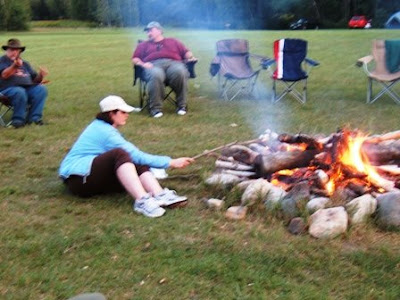
This round of testing was conducted at Marty and Aggie Simon's Wilderness Learning Center in Chateaugay, NY. Again, the tests were conducted out in the woods, not in a sound chamber. All of the ambient noises you'd expect in the woods played a part in this series of tests. As I expected, my observations from the initial series of tests held true. Those observations are:
1. Any whistle that was capable of routinely reaching 105 decibels (db) or better is worthy of serious consideration for everyday carry and/or inclusion in a PSK or 1st Aid Kit. Reaching/surpassing the 105db mark is going to get someone’s attention!
2. Ease of blowing to reach or exceed the level of 105db is a serious consideration. One with a lung condition such as asthma, COPD, or chronic bronchitis would be well advised to look at the whistles that have been noted as being “Very easy to blow” or “Easy to blow.”
3. Whistle construction is critical if you’re going to depend on it to survive. Look for quality construction. If you opt for a metal whistle and live in a cold climate, take precautions to cover the lip piece of the whistle with a protective sleeve of some type to prevent lip damage.
For this round of testing, I through in some interesting sound test twists. Enjoy...
 TOPS Knives (pealess)
TOPS Knives (pealess)Adult Average: 123.6
Child Average: 117.3
Overall average: 120.4 db
Very easy to blow. Two cord sounds gets everyone's attention. Irritatingly loud.
Victorinox SOS (pealess)
Adult Average: 122
Child Average: 110.6
Overall Average: 116.3 db
Same comments as above. Very similar design between these whistles with very slight differences in execution of design.
Bison Spy Capsule Whistle (pealess)
Adult Average: 108.6
Child Average: 111.3
Overall Average: 109.9 db
Very, very easy to overblow. Lip placement is critical with this model.
The following two whistles from Bison failed original testing due to construction flaws. The reeds were removed from both whistles and epoxied in place prior to this test.
Bison Small Cylinder (pealess)
Adult Average: 107.6
Child Average: 107.3
Overall average: 107.4 db
Very easy to blow. Easy to manipulate the sides of the exhaust port to change whistle tone.
Bison Large Cylinder (pealess)
Adult Average: 106.6
Child Average: 103.3
Overall Average: 104.9 db
Easy to blow. Very easy to manipulate the exhaust port to change tone.
US Navy Issue STORM (pealess)
Adult Average: 120.6
Child Average: 111.6
Overall Average: 116.1 db
Easy to blow. Requires a little more airflow than someone with a lung condition might be able to muster. A tad large for small kit consideration.
REI/Nexus Buckle (pealess)
Adult Average: 106.3
Child Average: 105.3
Overall average: 105.8 db
Very easy to overblow. Lip placement is critical.
London Metro PD Type / Railroad type (pealess)
Adult Average: 116
Child Average: 102.3
Overall Average: 109.1 db
Not so easy to blow. Requires a lot of airflow to achieve a high decibel meter reading. Unique sound surely gets folks attention when at max output.
Soda Can Whistle (pealess)
Overall Average: approx. 99db
*NOTE* We included this because it's something you can make in the field from a tin soda or beer can. Instructions can be found by attending Marty Simon's training classes. While the soda can whistle only achieved a decibel meter reading of 99, it's one heckuva lot easier to use this whistle than to expend your energy or voice shouting for help.
Some interesting twists -
Human Scream (pees after coffee or soda)
Adult Average: 107 db
Child Average: 104.3 db
*NOTE* Our adult tester, Kevin Estela (aka Estela216, a Moderator at KnifeForums), screamed three times the first at 110db, the second at 107db, the third at 104db. After the third scream, his voice was notably affected. By the next morning, he suffered a slight case of laryngitis from the event. Important to note! CARRY A WHISTLE! Our young adult tester, Becky Two Knives, screamed three times, the first at 101db, the second at 107db, the third at 105db. During her second scream, she belted out a change in tone that didn't even register on the decibel meter. That scream damaged the hearing of all present and scared the coyotes off Marty's property for a night.
Car Horn (pealess)
Average: 104 db
Tester with lung condition (pees after Yuengling)
US Navy STORM average: 102.6 db
Bison Capsule average: 115 db
*NOTE* It became blatantly apparent to me during this test that ease of blowing the whistle is of critical importance in whistle selection.
More tests to come in the upcoming months - stay tuned...
M
Edited to add a special note of Thanks to my assistants; Kevin Estela, Matt (cyclist), and Becky Two Knives.













 All in all, we had a tremendous time. Great friends, good food, and some excellent training. Everyone should make it a point to attend an event like WAR or PWYP...
All in all, we had a tremendous time. Great friends, good food, and some excellent training. Everyone should make it a point to attend an event like WAR or PWYP...















